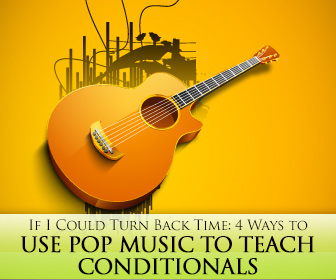How to Teach the Real, Unreal, and Past Conditionals


Here are four strategies to integrate pop music into your conditional grammar sessions. You can also use these as classroom breaks to keep reviewing these difficult tenses.

Differentiate between first and second conditionals, will and would, with a little help from the Beatles! Download the lyrics to “With a Little Help From my Friends”, pass them out to students, and play the song three times.
Use Cher to explain second conditional if clauses! Pass out the lyrics to “If I Could Turn Back Time” (or just the chorus).
For a homework assignment, ask students to find song lyrics in English that use “would have, could have, or should have” third conditional constructions. This is a particularly difficult verb tense because of the number of auxiliary words, but song lyrics integrate it often in simple speech and are hence a good teaching tool.
This lyric is used in a plentitude of pop songs and is perfect for teaching first conditional tense while simultaneously ingraining a commonly used English idiom! Favorites include:
Use one or two songs in class, and then ask students to find their own “I will be there” song on the Internet and pick apart the conditional clauses for homework! You can discuss their songs at the next class.
Try some of these suggested songs and activities to break up your class and reinforce the conditional concepts!